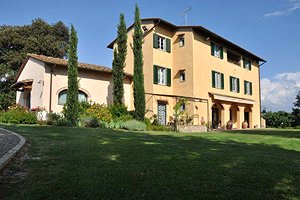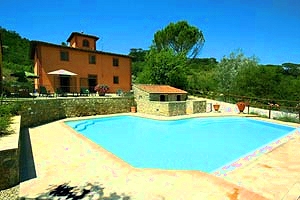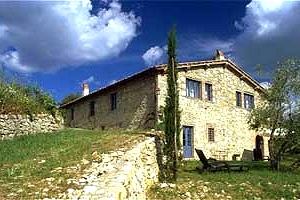



Chianti Wine and Oil

Unquestioned testimony to this is the finding of several vitis vinifera seeds that date back some twenty centuries. But the Chianti Classico that we know today dates to the first half of the 19th century, and is distinguished by a single name: that of Bettino Ricasoli, a personage famous for his great gifts as a politician and great Florentine statesman.
An enthusiastic vine grower and wine maker, he was the first person to set the proportions of the types of vines used to make Chianti, attributing a percentage to each of the main varieties of grapes traditionally present in the vineyards. With this dosage, the idea of Chianti as a wine to be drunk daily, of average body and excellent drink, suitable for all occasions and for accompanying any type of dish, was transformed. Thus, Sangiovese (very powerful and tanic) was adjusted with white grapes such as Trebbiano and Malvasia and with red grapes of a greater mellowness, such as Canaiolo and Colorino. But in recent years, the concept of wine itself has been transformed: wine is no longer solely an element of consumption, but can (and always more tends to) be a hedonistic fact, an element of refined pleasure.With great commitment and the combined action of unceasing technical improvement, ever increasing care in all the production phases, and the progressive elimination of white grapes (finally endorsed by the regulations in force) the absolute exploitation of the noblest type of vine, Sangiovese - by now considered among the most important in the world - has made been possible.
Thus today, Chianti Classico is the most structured and long-lived wine, suitable for ageing in wood from which it receives great refinement and elegance. The best vintages participate in international tastings on a level of absolute parity with the greatest French "crus", and always more often are successful in prevailing.
As far as oil is concerned, after a period of inactivity due to the disastrous freeze of 1985, production has now returned to its normal levels. To understand how much commitment is necessary on the part of the estates in order to achieve this result, we can simply say that most of the olive groves were lost, and in many cases olive growers had to start from scratch.
But it was worth it, because the extra-virgin oil from these lands is an exceptional product, thanks both to the characteristics of the soil and the climate and to the precious varieties of olives, as well as to the great oil-producing culture of the estates, the same ones that produce the great wines and are therefore used to working hard to attain a product of quality.
Obviously, a vision prevails of oil as an estate product, linked to the names, faces, histories, and also legends of the men and women who realise it. But one cannot be acquainted with Chianti and, in particular, with the zone of Greve if he or she has not tasted oil fresh from the oil press: oil just made that preserves a special fragrance throughout the region, but in particular in this land where taste, acidity and density are so well-balanced as to make it extremely precious. This particular fragrance lasts for only a few days, and must not be lost various versions of bruschette [Tuscan garlic toast], kidney beans in oil, pinzimonio [a dip of seasoned virgin olive oil in which raw vegetables are dunked] are irresistible when the oil has just left the olive press
With tie exploitation that has been made of the wine produced in the Chianti region since the times of Baron Ricasoli, it has become necessary to define the boundaries of this territory, which is located in the centre of Tuscany between the two cities of Florence and Siena. It includes the Communes of Castellina, Gaiole, Greve and Rada in Chianti in their entirety and those of Barberino Val d`Bsa, Castelnuovo Berardenga, Poggibonsi, San Casciano and Tavarnelle Val di Pesa in part In all, 70,000 hectares. Mostly covered by woods, Chianti Classico is a hill zone with altitudes ranging between 250 and 600 metres a.s.l .The climate is continental, but lacking in excessive ranges of temperature; the annual rainfall is about 800-900 millimetres. The soils are pebbly and not very deep, with gradients That are even considerable; they consist prevalently of sandstone in the highest zones and of alberese [a type of limestone rich in marl] in the lower ones.
The characteristics of the climate, soil, and altitude make Chianti Classico a region that is particularly dedicated to the production of top quality wine. Of the approximately 10,000 hectares of vineyards, only 6,912 are officially registered for the production of Chianti Classico DOCG (appellation of guaranteed and controlled origin). Chianti Classico DOCG can be produced by utilising exclusively Sangiovese grapes (minimum 75%, up to 100%), a type of red-grape vine originating in central Italy which gives rise to wines of a ruby-red colour that with ageing tends to garnet, with a bouquet of spices and small wild fruits, a good structure, elegant, rotond, velvety. Canaiolo (up to 10%), also a red grape, two white grapes, Malvasia and Trebbiano (up to 6%), and lastly, up to a maximum of 15%, other red grapes among those identified by the law, can also participate together with Sangiovese. Regulations provide for important production limitations, both as to the plants (maximum of 3 kg per strain) and to yield per hectare (75 quintals of grapes, or 52.50 hectolitres), the indication of minimum alcoholic content (12° for vintage wines, 12.5° for reserves), and the date the wine is put on sale (October 1st following the harvest).
Furthermore, the wine-making conservation, ageing and bottling must be done within the production zone The Marchio Storico - Chianti Classico Consortium, which has the qualification and promotion of the product among its main objectives, was founded by thirty-three producers at Radda in Chianti in 1924. They chose the black rooster, an ancient historic symbol, as their guarantee trade-mark, to distinguish the bottles of Chianti Classico produced by its members.At present, there are more than six hundred members (two hundred and fifty of whom bottle their wine under their own label), and these represent more than 80% of the total production of Chianti Classico. To obtain the Black Rooster trademark, the members must respect the technical indications of the Consortium and submit their wines every year to evaluations of tasting and to strict chemical analyses .... from `Greve in Chianti`(Municipality of Greve in Chianti)
Our most requested holiday homes:
 Villa rental with swimming pool for holidays near Montespertoli in the countryside of Empoli (Florence). Sleeps 12+2 , hydromassage, panoramic view, Internet connection.
More details
Villa rental with swimming pool for holidays near Montespertoli in the countryside of Empoli (Florence). Sleeps 12+2 , hydromassage, panoramic view, Internet connection.
More details
 Independent villa with private swimming pool in San Casciano Val di Pesa, in the Chianti district, near Florence. Sleeps 8/12, air conditioning, Internet connection, outdoor whirlpool bath sitting 7, children's playground. Possibility of organising cooking lessons and dinners. Tennis club, riding stable and golf club nearby.
More details
Independent villa with private swimming pool in San Casciano Val di Pesa, in the Chianti district, near Florence. Sleeps 8/12, air conditioning, Internet connection, outdoor whirlpool bath sitting 7, children's playground. Possibility of organising cooking lessons and dinners. Tennis club, riding stable and golf club nearby.
More details
 Tuscan villa with pool near Radda in Chianti in the countryside of Chianti between Siena and Florence. Sleeps 10, Internet connection.
More details
Tuscan villa with pool near Radda in Chianti in the countryside of Chianti between Siena and Florence. Sleeps 10, Internet connection.
More details
 Villa for vacation rentals in Siena countryside. 4+2 sleeping accommodations, swimming pool.
More details
Villa for vacation rentals in Siena countryside. 4+2 sleeping accommodations, swimming pool.
More details






